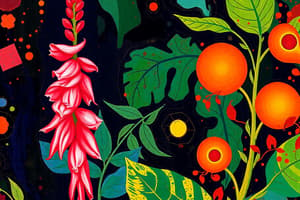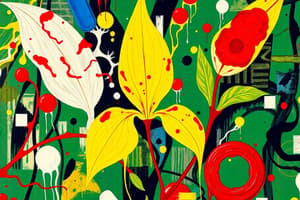Podcast
Questions and Answers
Which of the following plants is NOT a source of Atropine, Hyosine, or Hyoscyamine?
Which of the following plants is NOT a source of Atropine, Hyosine, or Hyoscyamine?
- Datura Fastiosa
- Solanum Tuberosum (correct)
- Hyoscyamus Muticus
- Atropa Belladona
What is a primary medical use of Atropine?
What is a primary medical use of Atropine?
- Antispasmodic for GIT (correct)
- Truth serum
- Stimulation in mania
- CNS depression
What is a notable symptom of Atropinism?
What is a notable symptom of Atropinism?
- Increased gastrointestinal motility
- Flushed skin (correct)
- Excessive sweating
- Decreased heart rate
Which mechanism best describes the action of Atropine and Hyoscyamine?
Which mechanism best describes the action of Atropine and Hyoscyamine?
What is one of the major considerations in the toxicology of Atropine?
What is one of the major considerations in the toxicology of Atropine?
Which treatment option is recommended for managing poisoning from Atropine, Hyosine, and Hyoscyamine?
Which treatment option is recommended for managing poisoning from Atropine, Hyosine, and Hyoscyamine?
In which situation is Hyosine used as a therapeutic agent?
In which situation is Hyosine used as a therapeutic agent?
What is a common cause of accidental poisoning with Atropine and its derivatives?
What is a common cause of accidental poisoning with Atropine and its derivatives?
Which classification of opioids includes both morphine and codeine?
Which classification of opioids includes both morphine and codeine?
What is the main mechanism of action for opioids in the central nervous system?
What is the main mechanism of action for opioids in the central nervous system?
Which of the following is NOT a symptom commonly associated with opioid overdose?
Which of the following is NOT a symptom commonly associated with opioid overdose?
Which of the following opioids is classified as a semisynthetic agent?
Which of the following opioids is classified as a semisynthetic agent?
Which investigation is most appropriate for diagnosing non-cardiogenic pulmonary edema associated with opioid use?
Which investigation is most appropriate for diagnosing non-cardiogenic pulmonary edema associated with opioid use?
Which physiological antidote is used to counteract opioid effects?
Which physiological antidote is used to counteract opioid effects?
What is a common cause of death in opioid overdose patients?
What is a common cause of death in opioid overdose patients?
What symptom might be expected to develop due to opioid-induced respiratory depression?
What symptom might be expected to develop due to opioid-induced respiratory depression?
Flashcards
What are Opiates?
What are Opiates?
Opiates are naturally occurring substances derived from the opium poppy plant. They contain various alkaloids, including morphine, codeine, and papaverine, and exert their effects by influencing opioid receptors in the central nervous system.
What are Opioids?
What are Opioids?
Opioids encompass a wider range of substances, including both natural and synthetic compounds, that share similar effects with opium. This category includes heroin, a potent semisynthetic opioid derived from morphine, along with synthetic opioids like fentanyl and methadone.
What are some uses for Morphine?
What are some uses for Morphine?
Morphine is a powerful analgesic used to manage severe pain, particularly in cases of burns, trauma, heart attacks, and even corrosive poisonings. It also plays a role in gradual withdrawal programs for individuals dependent on opiates.
How do opioids work?
How do opioids work?
Signup and view all the flashcards
What are the typical symptoms of an opioid overdose?
What are the typical symptoms of an opioid overdose?
Signup and view all the flashcards
What causes death in opioid overdoses?
What causes death in opioid overdoses?
Signup and view all the flashcards
How are opioid overdoses treated?
How are opioid overdoses treated?
Signup and view all the flashcards
How is an opioid overdose investigated?
How is an opioid overdose investigated?
Signup and view all the flashcards
What are Atropine, Hyoscyamine, and Hyosine?
What are Atropine, Hyoscyamine, and Hyosine?
Signup and view all the flashcards
How do Atropine, Hyoscyamine, and Hyosine work in the body?
How do Atropine, Hyoscyamine, and Hyosine work in the body?
Signup and view all the flashcards
What are some medical applications of Atropine?
What are some medical applications of Atropine?
Signup and view all the flashcards
What is Hyoscine used for?
What is Hyoscine used for?
Signup and view all the flashcards
How can poisoning by Atropine, Hyoscyamine, and Hyoscine occur?
How can poisoning by Atropine, Hyoscyamine, and Hyoscine occur?
Signup and view all the flashcards
What are the symptoms of Atropine poisoning?
What are the symptoms of Atropine poisoning?
Signup and view all the flashcards
How is Atropine poisoning treated?
How is Atropine poisoning treated?
Signup and view all the flashcards
What are the potential interactions with Atropine, Hyoscyamine, and Hyoscine?
What are the potential interactions with Atropine, Hyoscyamine, and Hyoscine?
Signup and view all the flashcards
Study Notes
Plant Poisons
- Plant poisons include atropine, hyoscyamine, and hyoscine
- Sources of these plant poisons include:
- Datura Fastiosa & Stramonium (Thorn apple)
- Atropa Belladona (Black berry)
- Hyoscyamus Muticus
- Active principles are atropine & hyoscyamine (isomers) and hyoscine
- Medical uses:
- Atropine:
- Ophthalmology: Mydriatic
- Chest: Bronchodilator (Asthma)
- Gastrointestinal Tract (GIT): Antispasmodic
- Urology: Urinary incontinence
- Toxicology: Antagonist in (morphine, digitalis, organophosphorus)
- Hyoscine:
- Used as a truth serum
- In mania, combats excitement and induces twilight sleep
- Atropine:
Conditions of Poisoning
- Accidental:
- Children
- Therapeutic overdose
- Addicts
- Homicidal: to facilitate rape & robbery
- Suicidal: overdose of anticholinergic medication
Mechanism of Action
- Atropine & Hyoscyamine:
- Anticholinergic:
- Central: block Ach release (CNS↑ then↓)
- Peripheral: block muscarinic action of Ach.
- Anticholinergic:
- Hyoscine:
- Central: CNS↓
- Peripheral: weak
Clinical Presentation (Peripheral)
- Atropinism:
- Dysphagia, Horse voice
- Constipation & urine retention (GIT & urinary motility)
- Dilated fixed pupil
- Flushed skin (due to dilation of blood vessels)
- Tachycardia + Tachypnea
- Atropine fever (inhibiting sweating & altering temperature)
- Central stimulation:
- Restlessness, agitation
- Disorientation
- Euphoria, talk
- Visual hallucination
- Occupational delirium
- Staggering gait
- Depression:
- Drowsiness, sleep
- Stupor
- Coma
- Cyanosis
Cause of Death
- Respiratory depression
Investigations
- Routine: CBC, ABG, electrolytes
- ECG: sinus tachycardia
- Chemical analysis (Tropin & Tropic acid)
Treatment
- Supportive measures (ABCs)
- GIT decontamination
- Local antidote:
- Acetylcholine (A.C.)
- Hydrogen Peroxide (H₂O₂)
- Sodium bicarbonate (NaHCO₃)
- Physiological antidote:
- Pilocarpine
- Physostigmine
- Symptomatic treatment
Opium: Heroin
- Opiates: naturally occurring opium
- Opioids: Alkaloids with opium or morphine-like activity
- Plant: Papaversomniferum
- Opium contains:
- More than 20 alkaloids (morphine, papaverine, thebaine, codeine)
- Ingested or smoked; has a meconic acid smell (unless injected, in which case it has no smell)
Classification of Opioids
- Natural: codeine, morphine
- Semisynthetic: diacetylmorphine ("heroin"), more potent than morphine, stadol, hydrocodone
- Synthetic:
- Meperidine and related (lomotil, Imodium, fentanyl, mepridine/pethidine)
- Methadone and related (methadone, propoxyphene)
- Other (pentazocine)
Uses of Morphine
- Pain killer (burns, metals, acute myocardial infarction, corrosive poisoning)
- Treatment of opiate addicts (gradual withdrawal)
Mechanism of Action (Opium/Heroin)
- Opioids interact with specific opioid receptors (mu, kappa, delta) in the CNS
- These receptors mediate analgesia
- Sigma is not an opioid receptor (not antagonized by naloxone)
Clinical Presentation (Opium/Heroin)
- Euphoria or dysphoria (distress & fear)
- Sleep, stupor, coma
- Non-cardiogenic pulmonary edema (dyspnea & cyanosis)
- Constipation, diminished bowel sounds
- Respiratory depression with cyanosis & characteristic smell in the breath (if opium).
- Hypothermia
- Circulatory collapse
- Miosis (pinpoint pupil), fixed pupil
- Skin boils, cellulitis, needle tracks (in IV drug addicts)
Cause of Death (Opium/Heroin)
- Respiratory depression (central asphyxia)
- Pulmonary edema
- Arrhythmias
- Irreversible brain damage secondary to prolonged hypoxia
Investigations (Opium/Heroin)
- Routine CBC, ABG, serum electrolytes
- Chemical analysis (morphine + meconic acid)
- Chest X-ray (pulmonary edema)
- ECG (hypoxic effects & arrhythmias)
Treatment (Opium/Heroin)
- Supportive measures (ABCs):
- Treat respiratory depression, coma, seizures, hypotension, non-cardiogenic pulmonary edema
- GIT decontamination: gastric lavage (cuffed endotracheal tube)
- Local antidotes: alkaloidal antidotes or activated charcoal
- Physiological antidote: Antagonists: atropine (1mL IV) ≠vagal stimulation & HR); Competitors (Agonist antagonist, pure agonist)
Studying That Suits You
Use AI to generate personalized quizzes and flashcards to suit your learning preferences.




